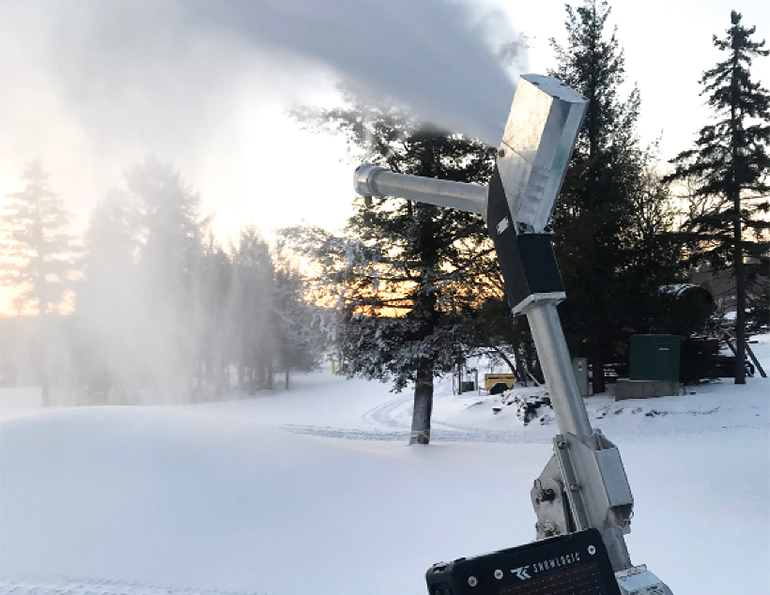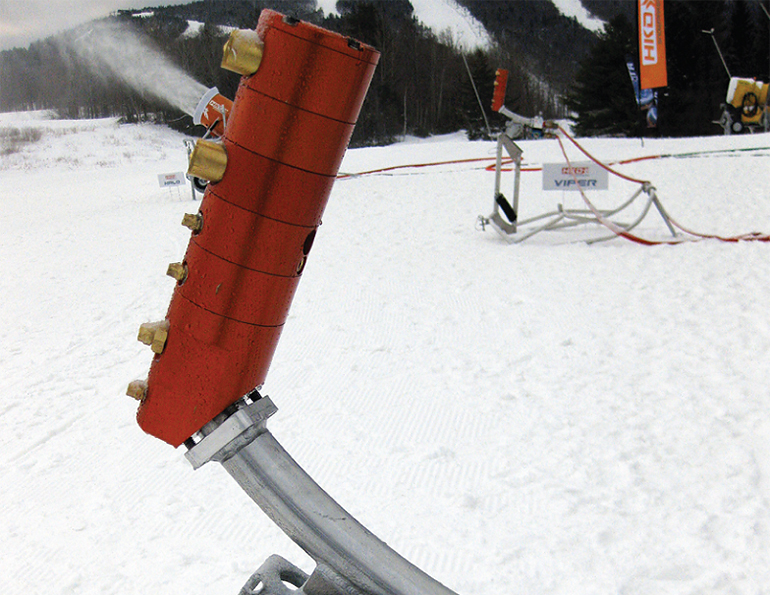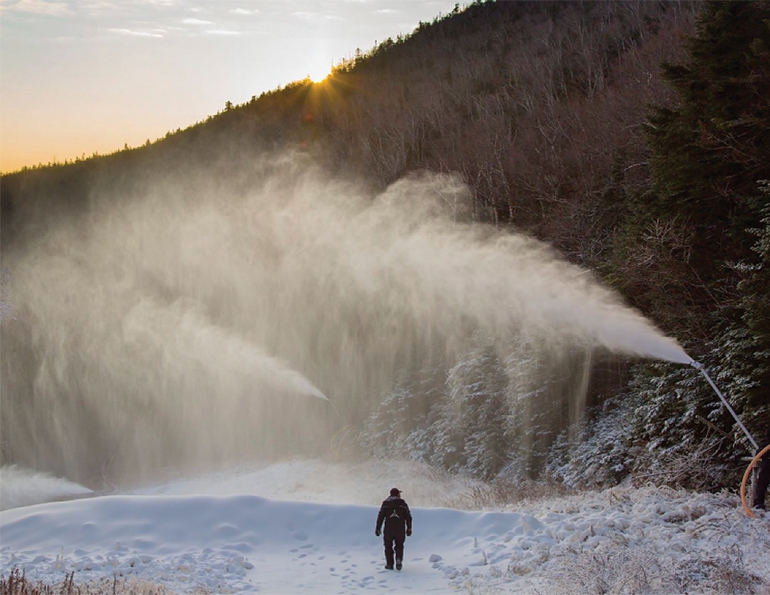Snow, natural and manmade, is a many-splendored thing. The Inuit of Labrador above the Arctic Circle have 10 basic words that describe snow, along with dozens of descriptions for various ice conditions. The Japanese scientist, Ukichoro Nakaya, studied ice crystal formation during the 1930s at a laboratory on Mount Fuji, and identified 41 general classifications for natural and manmade snow crystals. Physicists have identified 17 crystalline forms of ice that exist at various temperatures and pressures.
Fortunately, for snowmaking purposes, there is only one form, the familiar hexagonal flake, that matters.
The “state of the art” in snowmaking is a continuing and dynamic evolution that has progressed markedly since the first simple air/water snowmaking guns at Mohawk Mountain, Conn., fired up in late 1950. Visionaries, entrepreneurs, and market forces have pushed this process and technology to its present form. Over the past 25 years, technology improvements have reduced compressed-air energy consumption by a factor of 10, compared to the typical old air-water snowmaking systems, for marginal temperature operation. That’s a very dramatic change.
The snowmaking system at Mohawk represented an important step in providing a reliable snow surface. Today, 70 years later, snowmaking has become the cornerstone for guaranteeing a consistent season and reliable snow conditions. A brief historical review illuminates how this has come about, and explains why the process has become so efficient and effective.
The Science of Snow
The basic process of spraying water through a nozzle to produce a plume of water particles of a certain size and then let nature convert this to snow is simple to understand. Yet there is complexity in the execution. Two key elements, nucleation and water pressure, have influenced the development of all current fan and low-e air/water towers and sleds, and brought us to our current state.
The key role of nucleation. A water particle traveling through cold air requires a nucleation point to start the freezing process at a reasonable snowmaking temperature, otherwise it splats on the ground unfrozen. The best natural nucleation points are tiny ice crystals that allow the water droplet to change state and initiate the growth of a snowmaking particle at 32oF. Additives, sediment, and mineral particles in stream or pond water have a variable impact on freezing due to their much lower nucleation temperatures, ranging from 28oF down to single-digit temperatures.
The injection of seed ice particles via a nucleation nozzle into a water spray plume is one of the most pivotal ideas in snowmaking history. The first nucleating jets were introduced in electric fan snowmaking equipment by Dr. Wallace E. Howell and William Eustice of Hedco around 1970, and in low-e towers by Herman Dupre of Seven Springs, Pa., in 1973. This process has greatly improved the efficiency of the snowmaking process at temperatures above 18ºF for both electric fan and low-e air/water towers.
Water pressure matters. The second pivotal idea is the use of water pressures above 250 psig at the snow gun nozzles to accelerate the water/ice particles and to use the higher velocities to help break up and cool the particles while pushing them further out from the snow gun. This action creates a considerable amount of turbulence to promote better mixing in the snow plume. Older legacy systems were designed around 75 to 150 psig water pressure.
The incorporation of both ice nucleation jets and higher pressure water has improved the performance and energy efficiency of the snowmaking process markedly—the overall power use per acre-foot of snow production for air-water systems is just 25 percent to 50 percent of what it was 25 years ago. (The gains for fans have been more incremental.) These advances allow current snowmaking equipment to meet today’s environmental and business demands.
Who’s Who in Snowmaking Equipment
The chart below provides an overview of the manufacturers selling snowmaking equipment, automation, and system design services in North America. We’ll look at some of the common elements of these systems. A comprehensive look at the multiple options and specific details for each supplier would fill a book, or more to the point, several supplier websites.
 TABLE DEFINITIONS AND EXPLANATIONS Fan Guns: Number of electric fan gun models, with varying levels of output and technical sophistication, to suit different production requirements. Auto Run: Ability to operate autonomously under all weather conditions. Manual Run: Ability to manually control the unit if required or desired. Remote Control: Ability of the unit to communicate its operational status with a central computer or handheld device. Auto Hydrant: Water hydrants that control water pressure/flow or on/off through various methods of electronic communication. Applies to both fan and low-e towers and sleds. Low-e Tower: Number of stick gun models ranging in length from 16 ft. to 30 ft. with snowmaking head. Ground/Sled: Snowmaking head mounted on a short tower or tripod that can be easily moved or placed in a variety of locations. Flow Stages: Number of stages that control different levels of water flow to nozzles, to maximize production across a range of temperature and snowmaking conditions. Numbers show the range of stages across a company’s gun models. Variable Air: Number of models on which air flow can be adjusted in a limited fashion to suit warm or cold weather conditions. Mid-e Stick/Sled: Older style air/water snow guns with medium energy efficiency (using 200 to 300 psi air) compared to low-e guns and high-air-pressure (600 psi). Suited to special applications and low water pressures.
TABLE DEFINITIONS AND EXPLANATIONS Fan Guns: Number of electric fan gun models, with varying levels of output and technical sophistication, to suit different production requirements. Auto Run: Ability to operate autonomously under all weather conditions. Manual Run: Ability to manually control the unit if required or desired. Remote Control: Ability of the unit to communicate its operational status with a central computer or handheld device. Auto Hydrant: Water hydrants that control water pressure/flow or on/off through various methods of electronic communication. Applies to both fan and low-e towers and sleds. Low-e Tower: Number of stick gun models ranging in length from 16 ft. to 30 ft. with snowmaking head. Ground/Sled: Snowmaking head mounted on a short tower or tripod that can be easily moved or placed in a variety of locations. Flow Stages: Number of stages that control different levels of water flow to nozzles, to maximize production across a range of temperature and snowmaking conditions. Numbers show the range of stages across a company’s gun models. Variable Air: Number of models on which air flow can be adjusted in a limited fashion to suit warm or cold weather conditions. Mid-e Stick/Sled: Older style air/water snow guns with medium energy efficiency (using 200 to 300 psi air) compared to low-e guns and high-air-pressure (600 psi). Suited to special applications and low water pressures.
Fan Guns
Over the past decade there has been a natural convergence of snowmaking performance and automation for fan guns, in that five out of the six suppliers offer multiple models and options to suit every conceivable terrain and operating temperature situation. The smaller and much more portable fans are very useful for narrower trails, for example, while the larger and more powerful units can cover larger open spaces.
Common technology. Fan guns depend on variable water pressure and staggered water jets, or rings, to smoothly adjust water flow to the desired snow quality for the prevailing temperature, and are powered by electric motors to rotate the fan blades. A small electric air compressor is utilized for the nucleation jets.
Regional influences. Automation is more prominently featured on the European machines (DemacLenko, Sufag, and TechnoAlpin) to reduce labor costs. Power and water availability, along with environmental concerns, have driven their snowmaking equipment designs.
The U.S.-made fans have evolved along a different path, starting from the simple machines of 1970. The fans made by both SMI, the U.S. heavyweight, and HKD display the North American perspective in operation and control software for auto and manual operation. But domestic suppliers have also come to confront many of the same issues as the European manufacturers, and the SMI and HKD fans have characteristics very similar to the Euro models. Top Gun, in contrast, offers a simple, low tech, yet very effective fan gun as an alternative to all the above.
Water filtration. All the suppliers outfit their fan guns with fine mesh filters to catch debris and minimize the clogging issues that are the bane of small water nozzles, particularly on systems with uncoated steel piping, as is common in North America. Coated ductile iron pipe and intake water filtration are pretty standard components for snowmaking systems in Europe, and these minimize filtration needs.
Electronic controls. Similarly, all fan machines utilize sophisticated electronics, instrumentation, and PLC’s to achieve their performance potential. Typically, fan-gun control panels have touch pad/screen displays with multiple menus to drill down for control and other data options. A typical auto display will feature flow, pressure, and ambient temperature and humidity. One can communicate with these units through Bluetooth, Wi-Fi, radio, or hardwire. The use of a central computer(s) with multiple screen displays is common at many areas in the U.S., allowing the operator/system controller easy access to and control of the operating equipment.
Most of the suppliers have developed their own proprietary software. This can become an obstacle, though not insurmountable, if an area should choose to use multiple suppliers of auto snow guns and wants to integrate them into an existing control system.
Service. Perhaps the biggest long term issue with all the technology embedded in fan guns is the reliability of these components and the suppliers’ service response. This is an important consideration when selecting a sophisticated snowmaking product. Not all the companies may have the same level of commitment and support at 2 a.m. when the auto snowmaking system sputters and threatens to go down.
 TechnoAlpin TR8 fan guns.
TechnoAlpin TR8 fan guns.
 MND Snow (aka Sufag) Super Access.
MND Snow (aka Sufag) Super Access.
 DemacLenko Titan fan gun.
DemacLenko Titan fan gun.
 Three screen views of the DemacLenko Snowvisual software.
Three screen views of the DemacLenko Snowvisual software.
Low-e Towers
The low-e tower design was first introduced commercially by Snow Economics to the U.S. market in 1990, using Dupre’s design. It has steadily gained an enthusiastic clientele due to the inherent simplicity of its design and low air consumption. Every snowmaking equipment manufacturer has embraced this design. Continuing research efforts have improved nucleation jet performance to expand warm temperature performance.
Auto and manual modes. The 26 tower models in the chart can be had in a multitude of configurations, both automated and manual. The European models tend to be pushed with the auto mode, but the realities of the U.S. snowmaking headset has forced them to deliver the manual control mode also. Auto models often have the same electronic capabilities and hardware as the fans.
Multiple stages. Another important and notable progression is the use of water flow stages by means of valving to the snowmaking head itself. Nearly all of the suppliers have embraced the concept of variable water flow to expand the snowmaking temperature range and production capabilities.
Variable air. A number of U.S. suppliers have taken this a step further by incorporating variable air flow to the nucleation jets in the stage steps for improved marginal temperature operation. This feature, in essence, mimics the operational characteristics of the original air-water snow guns, but with a modern twist. For example, HKD, Ratnik, SnowLogic, and SMI models allow greater air flow at marginal temperatures for improved performance, and as temperatures decrease, opening additional water flow stages lowers the air flow.
Fine mesh water intake filters on low-e towers are mostly standard equipment, with a few exceptions. It behooves the user to insist on proper water filtration to minimize the possibility of clogging of the water and nucleation jets.
Mid-e Snow Guns
There still remain a number of snow guns utilizing the traditional older internal mix snowmaking technology that can operate in lower water-pressure conditions. These mid-e guns require less air than older versions (on the order of 200 cfm vs. 600 cfm) yet still yield excellent marginal temperature performance, along with the flexibility of excellent production throughout the snowmaking temperature range. Yes, the air flows are greater (and therefore costlier) than the low-e towers, but this also allows a greater throw and spread of the snow, along with a better performance under adverse wind conditions that can shut down the taller towers.
The Ratnik line offers multiple heads mounted on a variety of short towers and sleds and are well engineered, based on more than 50 years of snowmaking manufacturing experience.
TechnoAlpin offers two models of this type that are geared toward an automated system; one model can be operated in manual mode.
 SnowLogic seven-step mobile DV7 Striker with Rapid Fire automation.
SnowLogic seven-step mobile DV7 Striker with Rapid Fire automation.
 SnowGun Technologies Sledgehammer can be configured as a tower or ground gun.
SnowGun Technologies Sledgehammer can be configured as a tower or ground gun.
 HKD Impulse R5 on a Viper Tripod with five-stage R5 valve shifter.
HKD Impulse R5 on a Viper Tripod with five-stage R5 valve shifter.
Conclusion
Current snowmaking equipment meets the operational and performance characteristics that resorts require. There has been a true convergence of energy-related performance between fan guns and low-e towers. The huge reductions in compressed air needs have essentially leveled the playing field between the two methods, from an energy use perspective. The capability of both types to suit a wide range of environmental conditions has further converged with the addition of water flow stages to the towers.
The use of higher water pressure and technology improvements has altered the design of snowmaking systems and the process piping. Future gains in energy efficiency with the prevailing technologies will be incremental, and perhaps not cost effective for systems that have been recently updated. However, areas that have not yet adopted this technology can realize impressive gains in performance and energy efficiency.
Ski area operators can choose from a wide selection of snowmaking equipment to fit their unique terrain, regional weather patterns, and business plans. The spectrum spans from simple manual to complex automated technology, yet all can yield a high level of energy efficiency and performance. The finished product is environmentally friendly, in that it is completely recyclable and can be reused multiple times. The future beckons.
 SMI SmartSnow screens. Above: trail view with PistenBully SNOWsat snow depth integration. Click on a gun and get current operating information. Left: Pump station integration lets operator view run hours, status, flow rates, pressure, and total volume, and make adjustments.
SMI SmartSnow screens. Above: trail view with PistenBully SNOWsat snow depth integration. Click on a gun and get current operating information. Left: Pump station integration lets operator view run hours, status, flow rates, pressure, and total volume, and make adjustments.






